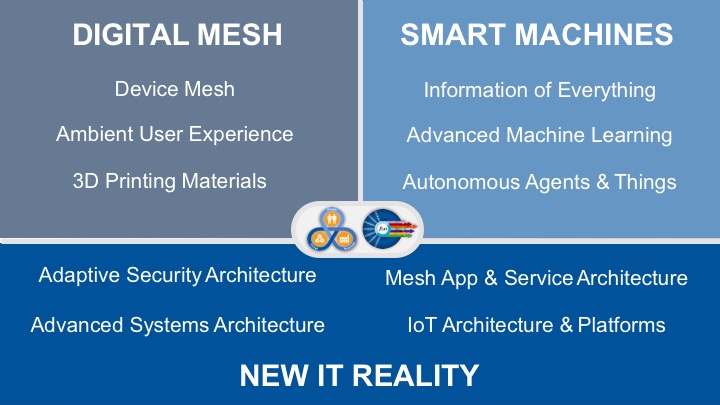The 10 tech trends of the future

Which technologies will guide and enable the most dramatic and significant changes in your environment over the next 3-5 years? This is the question Gartner asked to a large panel of CIOs and CEOs all over the world, then outlining the scenario of future technological trends that vice president & Gartner fellow David Cearly illustrated at the latest Gartner Symposium/ITexpo. There are three areas aroundwhich the 10 most significant technological trends revolve (figure 1). Indeed, in each of these areas, Gartner identifies the main technological trends that will guide and enable the digital transformation of companies in coming years.
A) Digital mesh
This is the highest expression of how ‘connections’ (between people, processes, information, ‘things’) occur. They represent the value of the digital business (enabled by the algorithmic business: algorithms – relationships and interconnections – define the future of business). This is where Gartner places the technologies that will allow the physical world to converge with the virtual one:
1) device mesh: expansion of devices through which people access applications and information or interact with other people, communities on social networks, public administration and companies. Device meshes do not just include the tools we are used to today (smartphones, tablets, etc.), but a whole series of endpoints ranging from wearable devices to consumer and home electronic systems (smart TVs, infotainment systems, etc.), as well as environmental devices and automotive devices, such as IoT sensors;
2) ambient user experience: the device mesh lays the foundations for a new user-experience model mainly focussing on immersive experiences (virtual and augmented reality) but not only; the experience ‘fluctuates’ through different sets of devices and interaction through different channels (physical, virtual, electronic);
3) 3D printing material: 3D printing has already dominated many sectors, but over the next years we will see the effect that this innovation will have on supply chain processes and assembly lines, namely in sectors such as aerospace, medical, automotive, energy and military.
B) Smart machines
In algorithmic business, much will happen without the direct involvement of people. This is where three important technological trends related to the IoT and M2M world will develop:
4) information of everything: everything in the digital mesh produces, uses and transmits information (text, videos, audio content, etc.); information of everything technologies will make it possible to ‘connect’ all data from the various sources and interpret them (semantic tools, graph databases, new data classification and information analysis techniques, etc.);
5) advanced machine learning: this is the evolution of neural networks through which the most traditional computing and information management systems produce systems that are capable of self-learning as well as understanding human language;
6) autonomous agents and things: machines’ self-learning ability will allow for the implementation of a wide range of smart machines (robots, autonomous vehicles, virtual personal assistants or smart advisors, just to mention a few examples).
C) New It reality
In this last category Gartner places the new architectures and platforms that will support digital and algorithmic business.
7) adaptive security architecture: the inherent complexity of the digital business and algorithmic economy, combined with the growing cyber-attack industry, will increasingly lead IT to think about new security architectures that will need to be adaptive and dynamically re-configurable by using technologies such as ‘application self-protection’ and ‘user and entity behaviour analytics’;
8) advanced system architecture: the digital mesh and smart machines require highly performing computing architectures; therefore strong evolution of ‘field-programmable gate arrays’ (FPGA) technologies are expected, as cornerstone elements for so-called neuro-morphological architectures (for the dynamic distribution of workloads generated by the algorithms that the machines will use);
9) mesh app and service architecture: enabled by software-defined application services, this new architectural approach will help achieve higher web-scale performance levels along with more flexible and agile systems. For instance, the so-called microservice architectures represent an emerging pattern to build applications made available both as on-premise and cloud applications (basically a solution is built as if it were a set, a suite of a number of microservices). Another important trend is related to technological containers hosting microservice architectures: these are very lean runtime environments that contain virtual machines with everything required to support the provision of the microservices;
10) internet of things platform: this will be an additional element alongside mesh apps and service architectures; namely, technological trends will direct aspects related to security, integration, management and standard communication protocols as elements on which IoT platforms can be built.